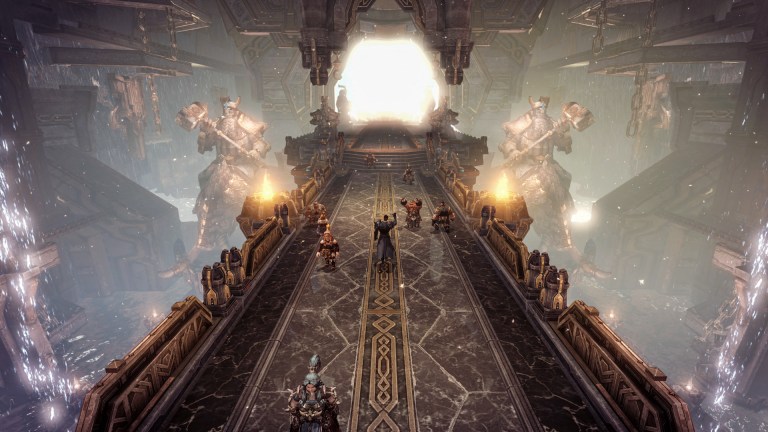Why Lost Ark Could Be the Future of “Pay to Win” Games
Some prominent faces in the gaming community are afraid that Lost Ark represents the future of “pay to win” design.

Lately, more and more video games have been playing with the parameters of “pay-to-win” game design. If those games are anything to go by, the gaming industry’s pay-to-win problem might get worse before it gets better. There are few better examples of this new era of pay-to-win techniques than the controversy currently surrounding the popular MMOARPG Lost Ark.
Lost Ark is one of the latest titles to come under fire for egregious microtransactions. It all started (or at least drew gamer ire en masse) with the launch of the MMO’s Argos Abyss raid. Like raids in other MMOs, the Argos Abyss tests player skill, cooperation, and equipment strength. In order to participate in the raid, though, players need an item level of at least 1370. At first, that requirement didn’t sound too bad. After all, most Lost Ark players can get close to that figure by earning a full set of Tier 3 gear through the normal course of play. However, the difference between getting close to that number and actually hitting it is where Lost Ark’s purportedly insidious pay-to-win design rears its head.
See, it turns out that players can’t even queue up for the Argos Abyss raid if they’re stuck at an item level lower than 1370. In other MMOs, gear requirements are more of a guideline than a rule. Players can still queue up when underleveled so long as they don’t mind being carried by their allies. Because that’s not the case in Lost Ark, you’ll eventually need to raise your item level by running your gear through the game’s upgrade system. That’s when the problems start.
The higher an item’s level in Lost Ark, the more resources you need to upgrade it. While that’s not necessarily unusual, it also turns out that the higher-level items are also less likely to “process” an upgrade attempt. At a certain point, the odds of a successful upgrade take a nosedive. Players can brute force the system to reach the Argos Abyss raid’s 1370 level requirement, but only if they are unreasonably lucky with their upgrade attempts and resource drops or choose to spend real money to expedite the process a bit.
On March 14th, Twitch streamer Asmongold called out Lost Ark’s developers over that tactic. He claimed that the game’s equipment upgrade system, which was more or less optional before the raid, had turned into a rigged game of chance. In Asmongold’s eyes, many players will be tempted to spend real-world cash on upgrade material just so they can participate in the raid. Not only that, but he believes potential teammates will pass over players with unupgraded gear in favor of those with max-strength equipment, and that players will soon be strongly encouraged (if not strictly required) to spend money just to keep up.
Asmongold repeated his concerns during a recent stream where he predicted a bleak pay-to-win future for games:
“I think pay to win games are the future. I think that they are, and I think more games will become pay to win. This is just what’s going to happen. I think that this is just what’s going to happen. Will there always be games like Elden Ring? Yes, but it’s like entropy, right? It will become fewer and farther between.”
Asmongold also predicted that the overall mindset regarding pay-to-win will do a 180. He claimed people will be “looked down on” and “considered socially inferior” if they don’t participate in the pay-to-win system, thanks in no small part due to in-game “social pressures.” Unfortunately, his hypothetical future might be even closer to reality than he realizes. In 2019, Polygon published an article about a middle school child who was bullied by fellow students because he used default Fortnite skins and hadn’t bought special outfits. The child purportedly “begged his parents for [money] to buy a skin because no one would play with him.” Sadly, that is hardly the only example of microtransaction-based bullying. Later the same year, the Children’s Commissioner for England organization published a study that demonstrated other young Fortnite players were bullied for not spending money on special in-game skins.
Genshin Impact is another fascinating example of a successful game finding new ways to push potentially pay-to-win microtransactions. That game infamously sports a huge roster of playable characters hidden behind what is known as a “gacha” system. The only way to unlock those heroes is to use gems that players slowly earn in-game or can purchase with real cash. In order to acquire the rarer and more powerful characters, players have to sink more gems into the gacha system and hope Lady Luck smiles on them. To make matters worse, players can upgrade characters by receiving duplicates from Genshin Impact’s digital slot machine. That means that in order to fully upgrade the rarest characters, you need to sink even more gems/money into Genshin Impact. There’s basically no escape.
Games like Lost Ark, Fortnite, and Genshin Impact have different monetization strategies, but it’s hard to not spot the similarities. Lost Ark has a luck-based upgrade system hidden behind a monetization paywall, just like Genshin Impact, and gamers who don’t use Lost Ark’s cash shop can either be locked out of certain experiences or ostracized (not unlike Fortnite players who use default skins). They’re games that hide their pay-to-win mechanics so well that you may not even realize how incentivized you are to spend money on them until doing so feels closer to an obligation than an option. Simply put, it’s becoming harder to spot pay-to-win games because the pay-to-win mechanics are becoming much more subtle.
Mind you, those are far from the only pay-to-win games out there. Warface is a notorious example since it didn’t start as a pay-to-win game but eventually became one thanks to a rental weapons system. Furthermore, while many pay-to-win games are technically “free to play,” far too many recent premium titles (including Assassin’s Creed Valhalla, Marvel’s Avengers, and NBA 2K22) have shipped with microtransactions that are slowly becoming more and more important in one way or another.
While Asmongold’s prediction might seem like doom and gloom, given all the games with obtrusive microtransactions and the social pressures they can easily place on players, his claims are surprisingly rational. Most pay-to-win games have microtransactions that either rely on low odds or can lead to social ostracization, but Lost Ark’s upgrade system and Argos Abyss raid requirements boldly utilize both of those concepts. The game may very well prove to be the testing grounds for how close a popular game can get to being pay-to-win without losing a significant number of paying players. Here’s hoping that won’t be the case.
